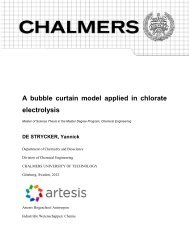A computational grammar and lexicon for Maltese
A computational grammar and lexicon for Maltese
A computational grammar and lexicon for Maltese
Create successful ePaper yourself
Turn your PDF publications into a flip-book with our unique Google optimized e-Paper software.
Foods> linearize Pred (These Cheese) (Very Expensive)<br />
these cheeses are very expensive<br />
dawn il- ġobniet huma għaljin ħafna<br />
Finally we can per<strong>for</strong>m a translation from <strong>Maltese</strong> to English by piping the output of a parse<br />
into a linearise comm<strong>and</strong>:<br />
Foods> parse -lang=Mlt "din il- ġobna hija tajba ħafna" | linearize -lang=Eng<br />
this cheese is very delicious<br />
1.3.3 Resource Grammar Library<br />
The example <strong>grammar</strong> in the previous section is small, but as <strong>grammar</strong>s grow in size having<br />
a module system becomes vital. Both abstract <strong>and</strong> concrete syntaxes can be split into separate<br />
modules, which promotes not only manageability but more importantly code re-use. Because<br />
the morphological <strong>and</strong> syntactic details of natural languages can be quite complex, it doesn’t<br />
make sense <strong>for</strong> every new <strong>grammar</strong> written in GF to have to re-implement these features. Instead,<br />
the low-level details of a language can be put into a resource <strong>grammar</strong> whose abstract<br />
syntax models phenomena on the syntactic level. A separate application <strong>grammar</strong> can then<br />
be written which focuses on the high-level modelling tasks, using functions defined in the resource<br />
<strong>grammar</strong> as needed. This additional level of abstraction in <strong>grammar</strong> design means that<br />
code <strong>for</strong> semantic modelling does not need to be mixed with code that h<strong>and</strong>les syntax <strong>and</strong><br />
morphology.<br />
Apart from the compiler <strong>and</strong> runtime system, the GF distribution also includes a st<strong>and</strong>ard<br />
library known as the Resource Grammar Library (RGL) (Ranta, 2009). The RGL provides<br />
general linguistic descriptions <strong>for</strong> natural languages which can be reused by using a common<br />
language independent API. This library covers the morphology <strong>and</strong> basic syntax of some 28<br />
languages from around the world (where <strong>Maltese</strong> is the 28 th language to be added). This<br />
means programmers who wish to use GF to write some application <strong>grammar</strong> do not need to<br />
worry about the tedious low-level details like word order <strong>and</strong> agreement in each language;<br />
they simply use the st<strong>and</strong>ard functions provided by the API <strong>and</strong> the linearisation into each<br />
language is h<strong>and</strong>led automatically by GF.<br />
Using the RGL in an application <strong>grammar</strong><br />
Continuing with the Foods example, we now show an example of the English concrete syntax<br />
which uses the Resource Grammar Library. We name this module FoodsEngRGL. Note how this<br />
module opens SyntaxEng <strong>and</strong> ParadigmsEng, which together make up the API to the library.<br />
In comparison to the previous version of FoodsEng above, FoodsEngRGL does not encode any<br />
linguistic in<strong>for</strong>mation itself. No parameters are defined <strong>and</strong> no agreement h<strong>and</strong>ling takes place;<br />
Instead, the categories are given linearisation types directly from the RGL; <strong>for</strong> example, Kind is<br />
given the type of a common noun CN. The function linearisations also look simpler — instead<br />
14















